
|   |

|   |
Indradhanush Dilli 2012 - Probal Gupta e-mail: probs_gupta12@yahoo.co.in Photos: Narender Singh January 31, 2012 SUNAINA, the Society for the Upliftment of National Arts of India, was established and registered on April 4, 1994 under the Societies Registration Act. Its founder president Guru Kanaka Sudhakar in association with other like-minded people has as her aim the spreading of our rich culture of dance, music and spirituality to the masses through education, training and research. One must commend the organization for not only the promotion of various dance forms of India through the dance festival Indradhanush at the cultural capital New Delhi, but also the measure of providing a sumptuous meal every day to the poor. 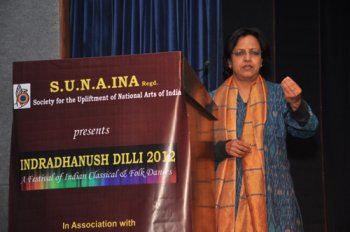 Tripura Kashyap One must curtsy for the courteous hospitality of the organizer from the time the artist places his/her foot in the capital city till the time he/she departs. From the excellent local hospitality to the delicious meals every day, one remains truly obliged to Guru Kanaka Sudhakar, Kshitij Sharma, Aparajita Sharma and the management committee of the festival who provided excellent support to the unassuming guru for the smooth running of the festival. Even though I performed at the fest, I could not help writing about the few recitals that I was able to witness. 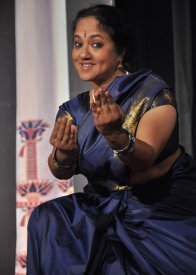 Kanaka Sudhakar The festival started on 14th Jan with a lecture on ‘Indian classical dance for health and spiritual awakening.’ Indian classical dances are performed to invoke rasa and take the audience into a meditative phase through effectual abhinaya. In order to prove this hypothesis, Kanaka Sudhakar’s paper along with her demonstration of the same through Meera bhajan “Jo tum todo piya” in raag Sindhu Bhairavi and tala adi really moved a person to tears. Not only that, if the artist is involved in intense spiritualism during the demonstration, the rasikas also submerge in a devotional awakening, leaving them spellbound. The therapeutic benefits of Indian classical dances for wellness were demonstrated through a new concept of ‘Yogic Aerobics’ with the help of five middle aged ladies. 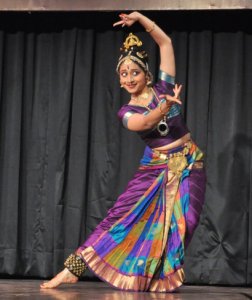 Prateeksha Kashi Prateeksha Kashi, daughter and disciple of Bangalore based Kuchipudi exponent Vyjayanthi Kashi, was the first artiste of the evening. Commencing her recital with “Pahi Pahi Jaganmohana Krishna Tarangam,” the aficionados were spellbound with the artiste’s petite looks. The first item, an excerpt from Krishna Leela Tarangini with the dancer balancing on the edge of the brass plate and dancing turned out excellent, but the unrestrained abhinaya and body movements in ‘Mahishasura Mardini,’ an item propitiating Shakti, needs to be relooked. With her perseverance and dedicated practice, Prateeksha is bound to evolve more. 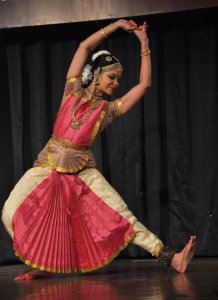 Navia Natarajan The Maharaja Swati Tirunal keerthanam “Pannagendra sayana” set to Ragamalika in adi tala by Navia Natarajan set the evening apart. Trained under Padmini Ramchandran, Navia has established a niche for herself. Neat teermanams, perfect adavus and thattu mettus called for a perfect performance. Eye contact with the rasikas embellished with appropriate abhinaya effectively conveyed the heroine’s desire for union with the Supreme, Lord Padmanabha. The micro macro mingling was superbly brought out in the abhinaya, evidence of her assiduous training. A little attentiveness towards the aesthetics of her costume would have accentuated the overall effect of her performance. 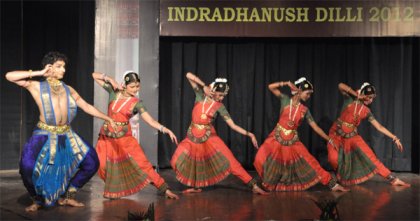 Pavitra Bhat & troupe Pavitra Bhat, one of the senior most and most active and seasoned disciples of Mumbai based Bharatanatyam guru Deepak Mazumdar was equally brilliant. Tastefully costumed, his pleasing stage personality is definitely an added advantage. Getting trained under a male guru who himself is a brilliant performer and understanding the subtle grammar of the male aesthetics to incorporate in the genre is definitely required especially for a form like Bharatanatyam. Pavitra’s perseverance has enabled him to adapt the male nuances which the form demands. Neat kudittas and teermanams without a slightest overdo in abhinaya definitely needs to be complimented. Commencing the recital with a self choreographed ‘Mahatripurasundari,’ a varnam dedicated to Maha Kali, Amba and Meenakshi set to raag Shivaranjini in adi tala, the aficionados enjoyed the synchronization of the group with the correct usage of the stage geometry. The Kalinga Narthana thillana set to the swara “ta rita tat jham” composed by Othukadu Venkata Subbaier was equally brilliant portraying the episode of the fight between Krishna and Kaliya within the river Kalindi. One enjoyed the dancer’s jumping into the river to search for the ball and the subsequent killing of the serpent Kaliya…. all done with aplomb. 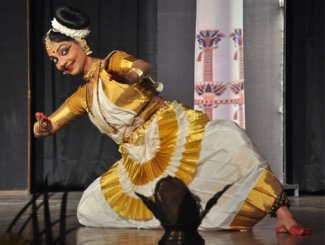 Deepa Chakravarthy However, the best performance of the evening was the Mohiniattam recital by Deepa Chakravarthy, disciple of Gopika Varma, which was definitely a complete metamorphosis of improvement from what this connoisseur has witnessed few months back at a dance festival in Bangalore. Entering the proscenium with “tam tam kita dhit dhit” vaittari juxtaposed with the striking circular movements set the choreography apart. “Lalita Labangalalata” set to raag Hindolam in adi tala with the dancer’s neat movements aggrandized with subtlety both in expression and nritta, set her recital apart. Restrained circular movements coming with intense practise of the chuzipoos to demonstrate the creepers, love of two cuckoos as a metaphor of the love of Radha and Krishna with the advent of spring were executed impressively. The Husseni thillana choreographed by Gopika was a refreshing addition to the Mohiniattam repertoire. Neat, graceful and languorous circular and semicircular movements derived from the chuzipoos, neat kalasams and meivazhakam accentuated her performance. 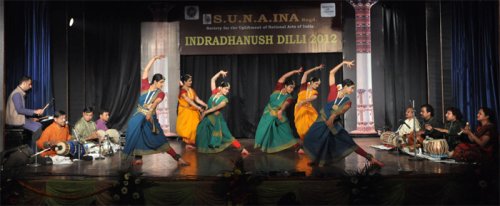 Tala Vadya Nritya Lahiri January 15, the second day of the festival commenced with the Tala Vadya Nritya Lahiri, a synchronization of Bharatanatyam and percussion, conceptualized by Kanaka Sudhakar. Good synchronization of the group and proper understanding with various live percussion ensembles elevated the quality of the festival to a significant extent and was definitely the best performance of the evening. The use of stage space by the dancers was noteworthy. Aparajita Sharma’s perfect adavus and precise expressions caught this aficionado’s attention. 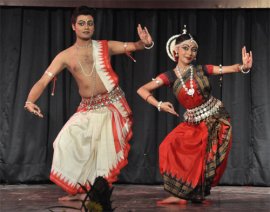 Subikash Mukherjee and Kaustavi Sarkar The Odissi duet by Subikash Mukherjee and Kaustavi Sarkar, senior disciples of Guru Ratikant Mohapatra, stood out for Kaustavi’s extraordinary performance. A male dancer, especially while performing with a female artist and specializing in a form where lasya occupies a predominant role, must concentrate on his masculine body language and the art of doing facial makeup. Commencing the recital with the Jugmadanda Pallavi initially choreographed by Guru Kelucharan Mohapatra and later re-choreographed by Ratikant for the dancer duo, one must definitely curtsy the choreographic brilliance of Ratikant to suit a male - female duet. The same goes for Ardhanarishwar choreography too. Kaustavi’s neat chalas (bama, prastha, dakhya and agra) enhanced with subtlety and grace was like poetry flowing out from her body. The Ardhanarishwar sequence with Kaustavi enacting the role of Parvati was excellent, with neat choreography and execution. The “Tak ta dhita” sequence with the dancer duo moving in equal tandem looked good. The mayura karana while defining “Champeya Garurardha” was beautifully executed by both dancers. Probal Gupta trained in Kathakali under two legends Late Kalamandalam Govindan Kutty and Guru Fact Padmanabhan under whom he is presently continuing his specialization in Stree Vesham genre of Kathakali. He writes for the Bangalore edition of The Hindu. |